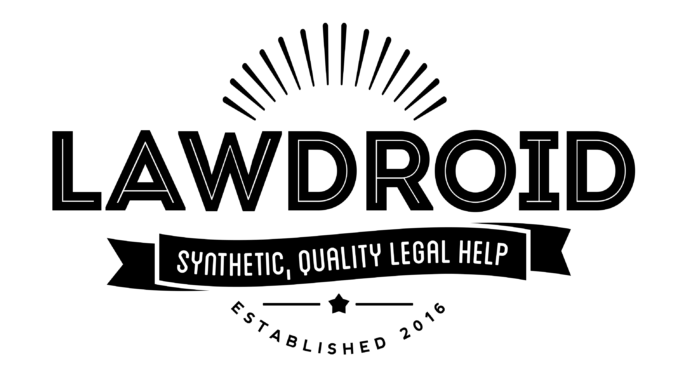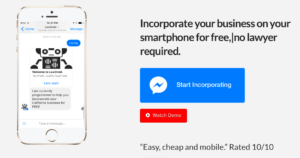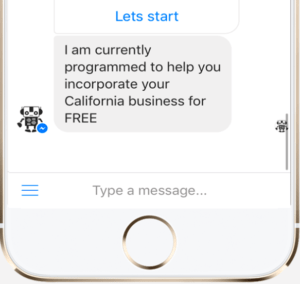
Artificial Lawyer recently caught up with Tom Martin, the California-based lawyer and founder of pioneering legal bot, LawDroid, which helps people to incorporate companies just with a smartphone. We discussed how LawDroid got started, the synergy between legal tech and access to justice, and how the US start-up hopes to grow in the future.

Hi, Tom, great to see a lawyer creating their own legal bot. It shows that not everyone needs to be a professional coder to get into legal tech. But, to begin with, can you please explain to readers what LawDroid does?
Although I am not a professional coder, I’ve learned html, css, and php over the years, which now seems elementary and outdated. I agree lawyers have a lot to bring to legal tech even if they’re not programmers.
I understand that your main legal focus as a lawyer in California has been probate and that you run your own firm, Foresight Legal. Where did the idea of LawDroid come from and why did you choose company formation as goal, rather than for example to help with probate issues?
Foresight Legal is my law firm and day job for the past 10 years. One of the first virtual law firms in the United States, Foresight worked in partnership with LegalZoom to launch a pilot program to provide prenuptial agreements to clients nationwide eight years ago. LegalZoom did the marketing and my firm provided the services. At its height, I managed over a dozen lawyers in as many States and serviced hundreds of clients across the country. The program was very successful and revolutionized and democratized a service that had been financially unattainable for many people.
In 2012, I founded an online marketplace for flat fee legal services called LawDeal with Allen Rodriguez, my friend and a former LegalZoom executive, who I got to know well from my business relationship with LegalZoom. We met with great success in signing up over 200 lawyers to participate in LawDeal and again democratized the pricing of legal services in a way that made them transparent and affordable. Unfortunately, the climate for investment in legal tech back then was quite subdued in comparison to today. Allen now runs One400, a very successful legal marketing company.
So, as you can see, I’ve been heavily involved in legal tech even before it became the category we now know and love.
The idea for LawDroid came from wanting to empower entrepreneurs to launch their business without the red tape and expense that typically accompanies incorporating with a lawyer or most online legal service providers.
As everyone knows, we now live on our smartphones and the way we primarily communicate on our phone is with messaging. I was shocked there wasn’t an easy, text-based option to incorporate. Sure, you can find mobile-friendly, responsive websites or apps for legal services providers but it isn’t quite the same thing as the ease of messaging. From a pragmatic standpoint, I suspected entrepreneurs (especially those fluent in social media) would likely be early adopters of the technology. I also wanted to focus on something very niche and simple so I could launch quickly, market the service more easily and gauge interest.

I was lucky with timing. Facebook just launched bots for Facebook Messenger in April of last year at about the same time the platform hit 1 billion users. I caught some great programmers right at the beginning of interest in chatbots and we put the bot together over the summer. LawDroid launched November 2016. The technology underlying LawDroid is a custom solution programmed in python. None of the off the shelf or open source bot creation apps would do because LawDroid incorporates document automation and that wasn’t something they could handle. There is natural language processing using Facebook’s wit.ai engine, but LawDroid is primarily a rules-based system or what has been called “Good Old Fashioned Artificial Intelligence.”
Does the system have a machine learning capability? I.e. does LawDroid get better at answering questions as it interacts with more and more clients?
LawDroid does not currently have machine learning capability because it’s not necessary to accomplish the task it’s currently programmed for (i.e., incorporation). It is enough at present for LawDroid to guide the user down a predetermined path of questions that leads to the preparation of articles of incorporation ready for filing.
But, I’m very glad you asked about machine learning! I’m currently working on LawDroid 2.0 and it will provide what I like to call ‘contextual answers’ to legal questions through use of natural language processing and machine learning.
At present LawDroid appears to conclude its service with the provision of the documents required. Could this be taken further into other areas of company law? And will you expand into new practice areas?
LawDroid’s service definitely could be and will be expanded into additional practice areas.
For the past couple of years, my law firm has been servicing tens of thousands of legal insurance members in Southern California by providing them with legal advice by phone. The requested advice could sound in criminal law, bankruptcy, landlord-tenant, divorce, personal injury or many other areas of practice.
In fulfilling this service, I have needed assistance from 3 lawyers to handle the volume of calls generated daily. Naturally, there is a pattern to the nature and content of calls and many involve simple legal questions where an automated response would be more efficient and cost effective. This invaluable experience puts me in a unique position to design conversations to automate provision of information. I am very excited by this next chapter for LawDroid. I’m looking to launch the new service this summer.

LawDroid is a freemium model. A user can complete the service and obtain articles of incorporation for free. Of course, there are a few upsells within the conversation for which I would charge. For example, the user could opt for me to file their articles of incorporation or to act as their agent for service of process and each would be an additional fee.
Fortunately, I was able to bootstrap this iteration of LawDroid because I got into this space early, but I am looking for an investor for the next phase. To date, LawDroid has had 290+ users.
LawDroid has already received several honors. Facebook selected LawDroid for its FBStart bootstrap track, a program that provides mentorship, tools and services worth up to $40,000. MaRS accepted LawDroid into its Venture Start Program that offers expert advice, mentorship and valuable connections. I have also been invited by Dr. Roland Vogl to present LawDroid to CodeX – the Stanford Center for Informatics in April.

Group Legal Services Association (GLSA) is an ABA-affiliated organization dedicated to legal plan providers, such as ARAG, Hyatt Legal Plans and Legal Shield, and the lawyers who work with them to service their plan members. By their nature, these legal plans achieve the goal of increasing access to justice by making legal advice and representation affordable and accessible for the average person. As the chair of GLSA’s Education subcommittee, my role is to educate the membership about new innovations in legal technology and I have the pleasure of hosting a monthly recurring podcast where I get to interview legal industry leaders, experts and personalities.
I like the ABA’s recommendations in its report on the future of legal services. I am grateful they dedicated the time and energy to this important subject. Improving access to justice is a critical, unmet need and not having access to effective legal help can have devastating, real world consequences for people who are unable to afford lawyers. I believe analysis of the problem is essential but implementing a solution is desperately needed. With LawDroid, I am doing my part to take action in crafting a solution.
Last question. It seems that an entirely new ecosystem of A2J legal tech applications are coming to market now. How far do you think this can go, especially as more AI technology is used in these apps? Can we significantly change the now famous figure of ‘the 80% of people with unmet legal needs’?
I am very excited to be in such fine company. I truly believe we can accomplish much in closing the gap in the general public being able to access simple, affordable legal help. AI will even the playing field by making not only legal information freely available, but also analysis and judgment. This is an exciting time and I understand how it can feel scary for legal practitioners who aren’t involved in the democratisation of legal services. But change is coming more quickly than we think and in 5 years some might look back and wonder how things could have ever been any different.
Also, Artificial Lawyer recommends everyone check out the LawDroid demo video, which is brilliant for two reasons. First, it’s a very clear demonstration of what LawDroid does. But, second, it’s the only legal tech video I have ever seen with a Nirvana soundtrack, and one of their best songs too.
5 Trackbacks / Pingbacks
Comments are closed.